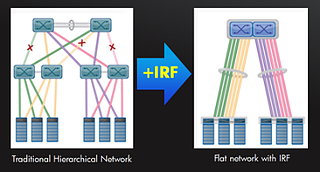Reduce your network complexity and boost performance with HP's Intelligent Resilient Framework (IRF). IRF is HP’s answer to reduce complexity and cost in switched Ethernet networks. IRF virtualizes Ethernet switches, providing an intelligent, unified network that boasts numerous benefits over ordinary approaches built on Spanning Tree Protocol (STP). IRF flattens your network, eliminating the aggregation layer and provides a common, virtualized fabric spanning data center core, distribution, and access layers. This administers more direct, higher capacity connections between the user and network resources. IRF extends network control over multiple active switches, up to nine, consolidated around a single management IP address to create an ultra-resilient virtual switching fabric.
IRF Advantage: Simplicity

Design and Operational Simplification, Flatter Topology
- Simplify network setup, operation, and maintenance with a single virtual switch that operates across network layers rather than managing switches individually. Layers two and three operate as a secondary backup in the event of primary switch failure.
Less Device Configuration
- IRF Advantage: Performance IRF simplifies initial network design and ongoing network operations by 85% or more by consolidating configuration files. Up to nine devices are operated from a single configuration file, reducing the administrative load and the potential for the introduction of function-impacting manual configuration errors.
Higher Efficiency
- Loop-free non-blocking architecture keeps all links active, providing high-bandwidth connectivity throughout the switching plane.
Scalable Performance
- Bundle several parallel links between switches and servers with IRF and Link Aggregation Control Protocol.
Faster Failover
- Rapid recovery and network convergence under 40 milliseconds (faster than the several seconds required by STP).
IRF Advantage: Resiliency
Distributed High Availability and Resiliency
- IRF fabric can be configured for full N+1 redundancy. Mission-critical virtualization capabilities, live migration and application mobility, across IRF domain and extend across the Layer Two WAN infrastructure.
Geographic Resiliency
- Switches can be extended horizontally and continue to function as a single logical unit whether locally installed, distributed regionally, or situated across distant sites. Link installations up to 70 kilometers apart, providing the same failover rate of in-house servers.
In-Service-Software-Upgrade (ISSU)
-
Switches have the ability to be taken offline for services without effecting or disrupting traffic to other switches in the IRF domain.
HP’s IRF approach is unique, encompassing not only automate optimization/recovery and switch virtualization, but delivers substantial simplification and automation of network management tasks. VLCM is pleased to be a certified partner with HP. When you team up with VLCM, you’ll benefit from proven services and products. Please contact us for more information.
Sources:
HP White Paper: Reducing Network Complexity, boosting performance with HP IRF technology

